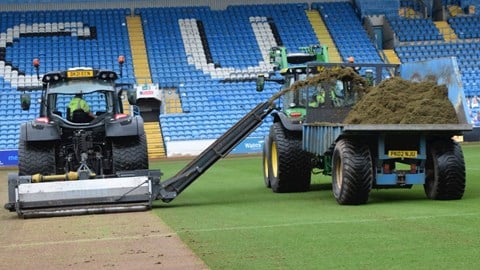As you’ll have seen on social media over the last few days work has started in earnest on the Brunton Park playing surface, with the highly commended pitch now resembling a ploughed field in preparation for seeding and the important period of regrowth ahead of the return of football in July.
A fair and expected reaction when we announce that the machinery is on the way to do the job is when people ask why an award-winning playing area needs to go through this type of process, particularly when the club is managing costs across the board.
Stadium manager Dave Mitchell said: “It is a fair question, but what we’re got to be careful with is that what fans see on the top when they watch the games being played is one thing, but there’s all sorts going on underneath.
“If we want to provide the best kind of surface sometimes we have to accept that additional work must be done, and that obviously comes at a cost. In terms of what we’re doing now, it’s a bit longer-term fix rather than something that won’t last too long, but if you had the budget you’d probably do it every year.
“You wouldn’t necessarily have to add the tonnage of fibre sand each time, but you’d plough it up just for aeration purposes. Turning it over also makes it looser and easier for the roots to get down, which leads to a healthier plant.
“Prior to Storm Desmond we tried to do it on a two-year cycle where we’d turn it over one year and then just scrape the top the next year. The EFL have brought in standards now and you’re in the dock if it’s not up to scratch. That’s good, but obviously there’s a cost involved for the work needed if it’s not at that level.”
On the challenges posed by the pitch heading into the summer, he told us: “We’ve got issues with the pH, which is the acidity. Perennial Rye Grass likes to grow in pH5.5 – I’m sure we all remember the litmus test at school, with the blue and the red – and at the moment in places across the pitch it’s pH4.
“That’s far too acidic to allow grass to be healthy, and we had that problem as we went through last season, so that’s another factor to add as to why we need to put things right. With the weather we had, and the lack of grass cover, you can start to see that the grass we did have wasn’t enjoying its environment anyway.
“To adjust that acidity to get it closer to where it should be we’ll put some lime in there, and that neutralises it. To get the lime in we have to plough it up, which is pretty much what a farmer does when he turns the soil over in a field before planting the next crop.
“We’re also doing it to get more trace elements in like magnesium, boron, manganese, and all kinds of things like these. It’s just like you and me and the blood in our bodies, we need traces of vitamin D, vitamin B12, whatever, just to keep ourselves functioning properly.
“If we don’t have those things we start to feel a little bit not quite right. With the pitch, add on that the fact that it was being used on a Saturday-Tuesday repeatedly, and all of a sudden it’s under pressure.
“It’s not just the playing side of it, it’s the recovery period it needs between games that it doesn’t quite get so that it’s ready for the next time.”
“Another reason for doing this work is that with the players being on it, and then the machinery we use to look after it day-to-day, the surface becomes very compact,” he explained. “It hasn’t been turned over and aerated to this extent since May 2015, post-Desmond.
“It’s way overdue when you think of it in those terms. That’s probably the main reason behind why we’re doing it now and, as I say, we might as well take the opportunity to balance the acidity and get some of the minerals back into it as we’re going along.”
So what exactly goes in to a process like this?
“The first thing was to get the top 10mm off, and the next phase is to get it cultivated,” he said. The lime will then go on, the other base elements will go on, and then we have 87 tonnes of fibre sand concentrate to get on there.
“That will then be cultivated in and it gives us a concentrate of 0.3%, which is ok. Again, it’s a little bit closer to where we want to be. To put it totally back in proportion we would have gone for 312 tonnes, but obviously budget comes into that, so we can only chip away at it bit by bit.
“The good thing is we have a bit more on the budget to do this work this year which is why we’re going as far as we are with it. It’ll take about two or three cultivations to get it nice and mixed, and it’ll need a bit of hand work around the sprinklers. From there we use a stoneraker machine to level it up before we start to seed it.”
“Hopefully it’ll be seeded by the time this article goes live,” he added. “We’ll use the sprinklers to keep it watered, but we’re hoping nature will lend a hand because the sprinklers are nowhere near the same as rainwater.
“This pitch has changed dramatically just with the rain we’ve had over the last two-or three week period. We had a very dry April, also cold, but the rain at the start of May – ironically after the last game – you could just the see the pitch picking up because of it.”
Removing the very thing the club is all about – its football pitch – must bring with is certain anxieties as the clock starts to tick towards the date of the first home pre-season friendly.
“No, not really,” he insisted. “But you do get a bit anxious if things aren’t happening by week four or five. If there are gaps in the seed drills, and bits and pieces like that, you have to work on it.
“You always get a leaf spot disease, which is a fungal disease, around about week three or four, and if you don’t tackle that you lose about a week of growth.
“What I will say is that you need the biggest window possible to get the work done because you know that potentially there’ll be a week lost due to a bit of ill health.
“We could potentially have a heatwave where you need to water it non-stop, and then because you’re watering it you lose all the goodness from the fertiliser. Basically all the good work you’ve just done is getting washed through so you have to put more on, and the costs go up.
“The bottom line is that it’s a mad rush to get it ready for whatever date that may be. In amongst it all we’re also doing the training pitch and the pitches at Creighton.
“We’ll be putting 100 tonnes of sand on the back pitch and a bit of sand up at Creighton. I’ll be doing the rest of the aeration work up there, and both areas will be seeded and maintained as we go through the summer.
“There’s been training at Creighton last week and this week, then they players might be back at the end of June, so the window to work in is as small as we could possibly get.
“It’s all a challenge but it’s work we need to do, and it’s just a case of getting on with it as efficiently as possible.”
Click HERE to watch an interview with Dave Mitchell on iFollow United now.
Click HERE to see a clip from this interview on our YouTube channel. Follow the same link for more FREE content right from the heart of the club.












